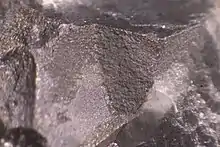Crookesite
Crookesite is a selenide mineral composed of copper and selenium with variable thallium and silver.
| Crookesite | |
|---|---|
 | |
| General | |
| Category | Selenide mineral |
| Formula (repeating unit) | Cu 7(Tl, Ag)Se 4 |
| Strunz classification | 2.BD.50 |
| Crystal system | Tetragonal |
| Crystal class | Disphenoidal (4) H-M symbol: (4) |
| Space group | I4 |
| Identification | |
| Color | Lead-gray |
| Crystal habit | As finely divided, disseminated specks, and as small veinlets. |
| Cleavage | Good, two at right angles |
| Fracture | Brittle |
| Mohs scale hardness | 2.5–3 |
| Luster | Metallic |
| Diaphaneity | Opaque |
| Specific gravity | 6.90 |
| References | [1][2] |
Characteristics
Its chemical formula is reported either as Cu
7(Tl, Ag)Se
4 or (Cu, Tl, Ag)
2Se.[3] It is formed by precipitation from hydrothermal fluids, and contains by mass: 16.3% Tl, 47.3% Cu, 2.9% Ag, and 33.6% Se.[1]
Crookesite is an opaque, bluish grey to pink toned brown metallic mineral crystallizing in the tetragonal system. It has a Mohs hardness of 2.5 to 3 and a specific gravity of 6.9.
Name and discovery
It was discovered in 1866 in Skrikerum, Sweden and named for Sir William Crookes (1832–1919), the discoverer of the element thallium.[1]
References
- Berger, Rolf A.; Sobott, Robert J. (1987). "Characterization of TlCu7S4, a crookesite analogue". Monatshefte für Chemie. 118: 967. doi:10.1007/BF00815324.
- Berger, R..A. (1987). "Crookesite and sabatierite in a new light A crystallographer's cornrnent" (PDF). Zeitschrift für Kristallographie. 181: 241–249. Bibcode:1987ZK....181..241B. doi:10.1524/zkri.1987.181.1-4.241.
This article is issued from Wikipedia. The text is licensed under Creative Commons - Attribution - Sharealike. Additional terms may apply for the media files.
